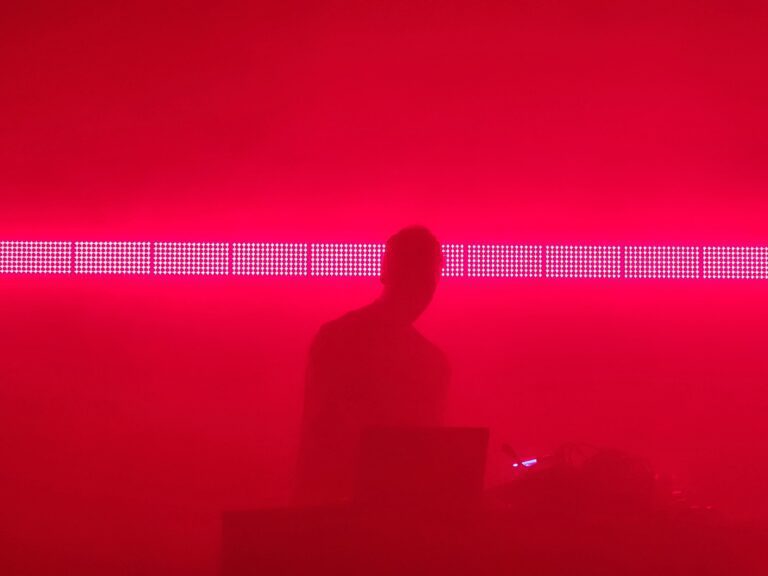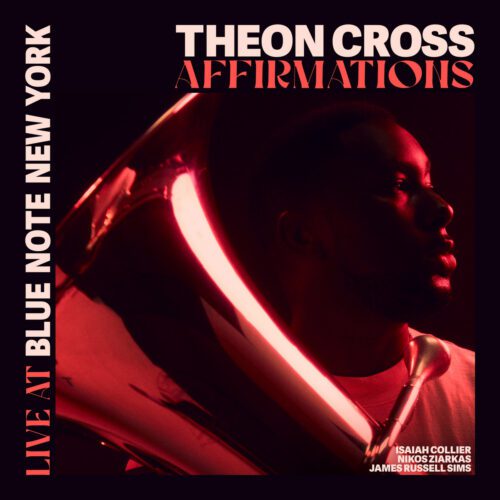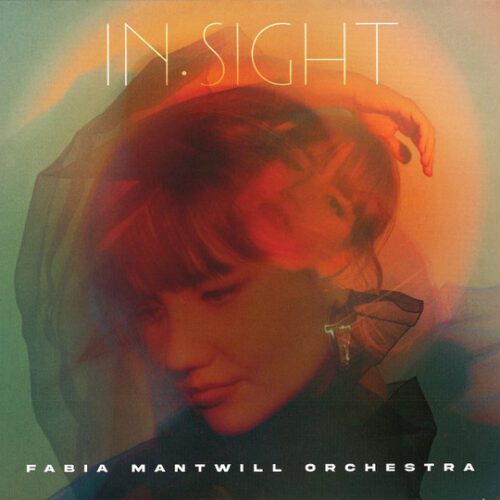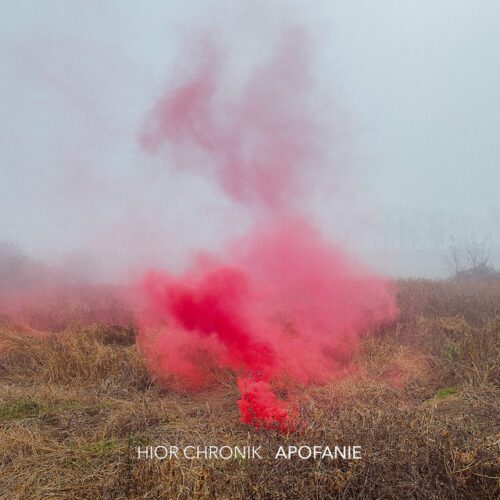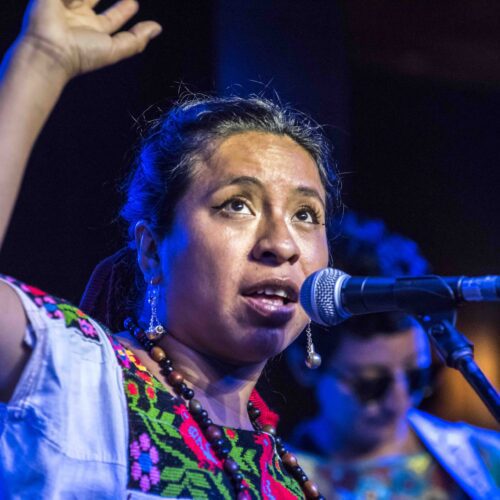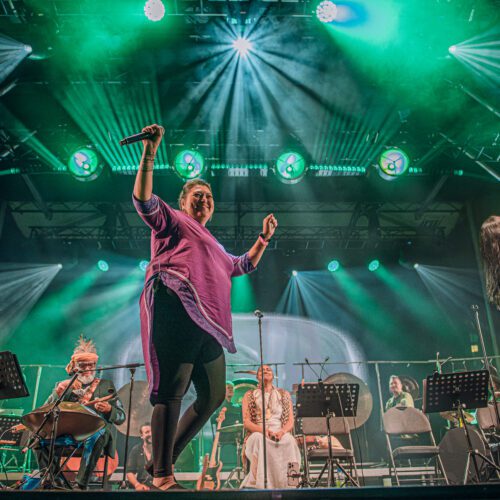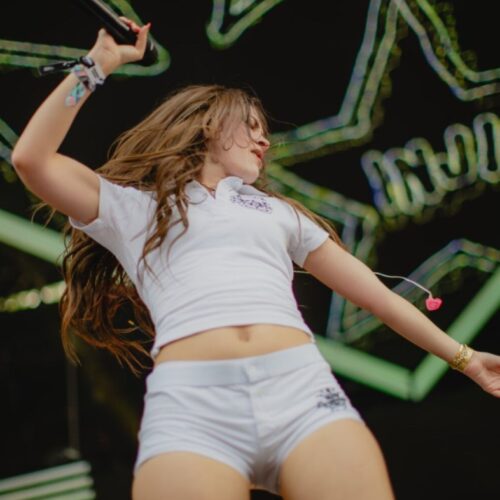MUTEK Montréal 2023 and PAN M 360, a combination that makes perfect sense! That’s why our team is focusing on it this week. Fans of cutting-edge electronic music and digital creation are in Montreal this week, so follow our team’s vibrant coverage through Sunday!
Experience 1
On Tuesday, May 22, Mutek Montréal 2023 took to the air on the Tranquille esplanade in the Quartier des spectacles. Outdoors and free? This is not outdoor programming made up of the leftovers from our indoor line-up, but rather a mix of internationally established artists whose current buzz here at home doesn’t yet justify paying admission.
– Alain Brunet
Leon Louder
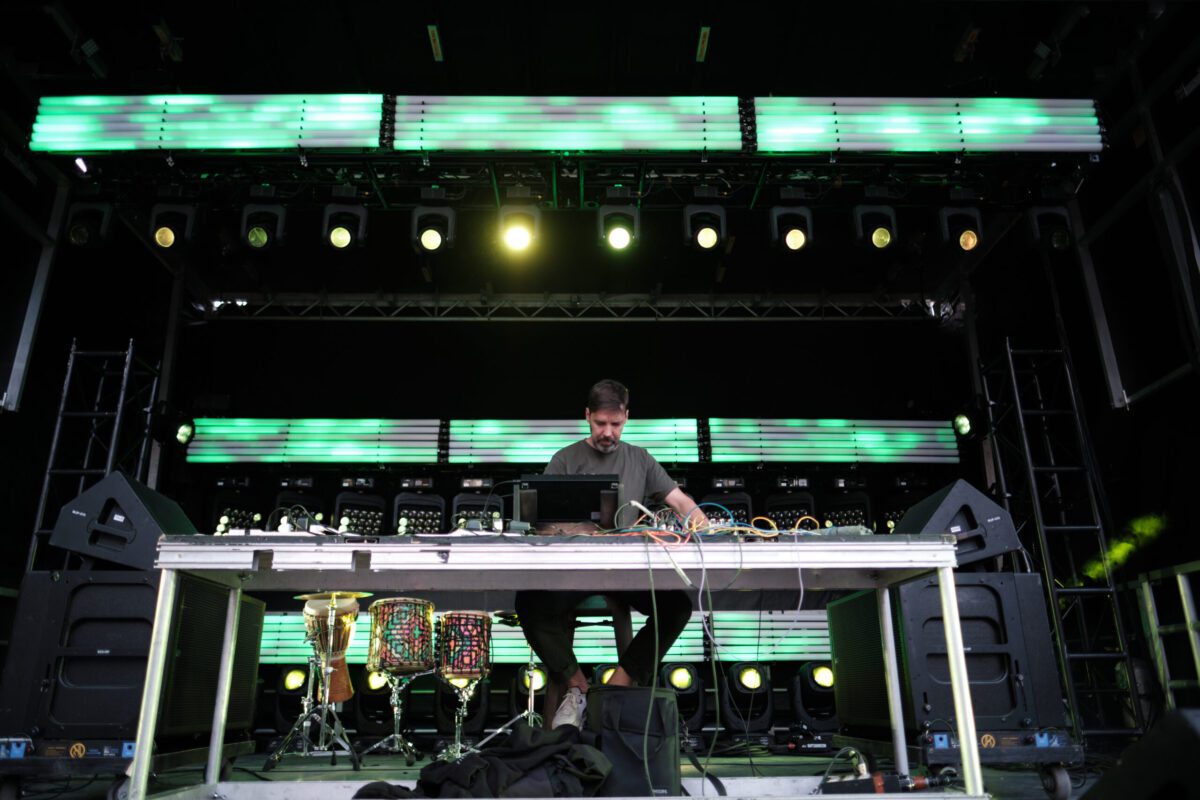
// Vivien Gaumand
With Leon Lounder, the audience wasn’t sure whether to listen with the body or with the head alone. On the one hand, the pulse was drowned out by a sound design built around insect sounds, commissioned by the Insectarium de Montréal. Here, harmony and melody were not parameters. Rhythm, on the other hand, was mostly created by sound phrasing of a certain length, repeated in loops. Later, low frequencies changed the texture and were coupled with short sounds, but repeated so rapidly that they created the effect of continuous sounds. Towards the end of the performance, a more harmonic passage with what gave the illusion of being synthesized voices came to confuse this entomological music.
– Laurent Bellemare
Moon Apple

// Vivien Gaumand
That said, the Expérience 1 series also features emerging artists who have yet to fine-tune their proposals, but who show interesting potential. Such is the case of Moon Apple, an adopted Montreal producer whose grandmother became a Buddhist monk, which inspired her pseudonym. Equipped with modular synthesizers, a loop pedal, and percussion instruments, the musician offers an organic sound filtered by various effects whose purpose could be ritualistic at times. She also sings and taps live on a digitized surface. A little clumsily, we noted, when the rhythmic pattern was combined with other pre-recorded sequences,
It presented a kind of ceremony whose purpose was to represent the Four Pillars of Destiny. Guests Dédé Chen, author, and performer, and Ahreun Lee, multimedia artist and musician, came to lend a hand to a Moon Apple symbolically addressing mythical creatures – at least that’s what it says on her biographical profile. This integration of melodic synth-pop into this multi-layered experience is interesting but still needs some care before it hits the bull’s eye.
– Alain Brunet
Moon Apple’s music contrasted with the opening performance. The artist immediately immersed the audience in a harmonic universe of soft tones and ethereal vocals. Despite this delicacy, powerful attacks in the lower register quickly saturated the frequency range, creating a resounding yet soothing bath of sound. The musician from Seoul, Korea, incorporated some instrumental interpretation, notably with the rhythms she played on a digital pad before looping them. Unfortunately, these sequences were not synchronous, which even led the artist to abandon this technique towards the end of the performance. On the other hand, the highly processed vocals of the two guest artists added to the pop sound that must surely be delectable on the album.
– Laurent Bellemare
Indus
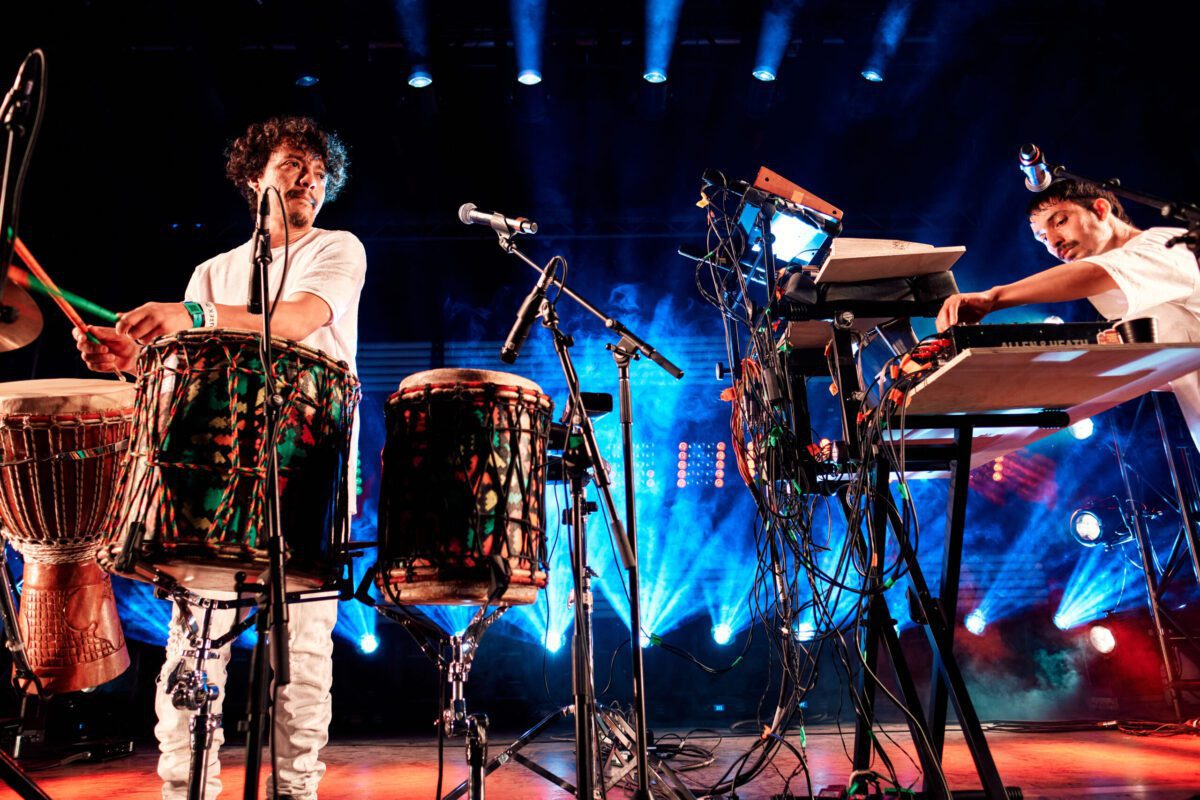
// Vivien Gaumand
This Colombian duo, self-proclaimed “electro-folk”, was the act that brought the house down. From the very first strokes of the Tambora combined with the powerful electronic rhythms, the audience started dancing. The catchy music was interspersed with samples of voices singing choral songs, although in the end the rhythm and bodily performance outweighed any melodic or harmonic content. Decidedly, the marriage of traditional percussion with electronic music is a winning recipe, as Indus’ performance was undoubtedly the most energetic of Expérience 1.
– Laurent Bellemare
Exclusive to the program, Colombian duo Indus made a splash on the Tranquille esplanade. Indus is made up of producer Oscar Alford and percussionist Andres Mercado, whose album of the same name did not go unnoticed in 2020. Indus’ appeal is based on the use of Afro-Colombian and Afro-descendant chants and rhythms (champeta, currulao, mapalé, etc.) at the heart of a rather pop electronic approach, in line with much of the genre’s dance-floor-oriented music. The vocals may occasionally sound a little out of tune (a problem with the monitors?), but the overall quality of the work made us forget about these minor discrepancies. Indus’ approach is solid and unifying, with warm percussive rhythms and traditional vocals blending well with the synthetic keyboards and other digital tools that make up the lutherie of this well-received tandem.
Alain Brunet
Opening event at New City Gas: Grand River and Tim Hecker
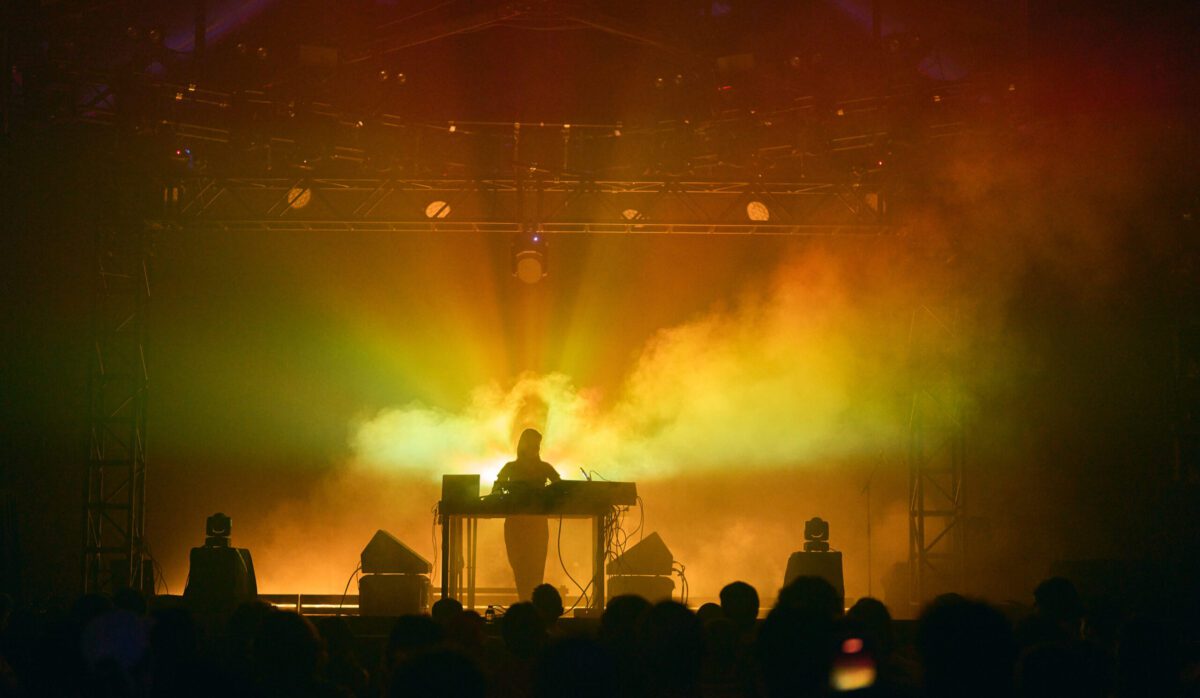
// Bruno-Aiello-Destombes
At New City Gas in Griffintown, the huge New City Gas club hosted the opening indoor program. Perfectly renovated (since 2012), this factory dating back to the Industrial Revolution (1847) boasts a surprisingly efficient sound system for the concert format.
The first artist on the program had never performed at MUTEK before but enjoyed a genuine buzz in MUTEK networks. And the buzz is perfectly justified! With origins in Italy and the Netherlands, Berlin-based Aimée Portiori, aka Grand River, offers marvelous superimpositions for fans of ambient music steeped in minimalism. She chooses to insert a few consonant chords and melodic or choral fragments as beacons for her brilliant explorations. In the vein of Christian Fennesz and Tim Hecker, Grand River’s electroacoustic proposals are laced with multiple tasteful synthetic filters. They are set to rhythms that are generally slow, sometimes faster, and more robust, but which have nothing to do with the binarity essential to the dance floor.
– Alain Brunet
Grand River’s performance was one of those that operated by gradually densifying the musical material. With very little development, the various moments of the show were built on short melodic loops and an accumulation of sound layers. Rhythmically, we moved from total abstraction to pulsation. Moments of contrast between slow keyboard chords and background noise, or vocal sampling, occasionally extended the artist’s sonic range, plunging his audience more than once into a form of urban trance.
– Laurent Bellemare
Tim Hecker
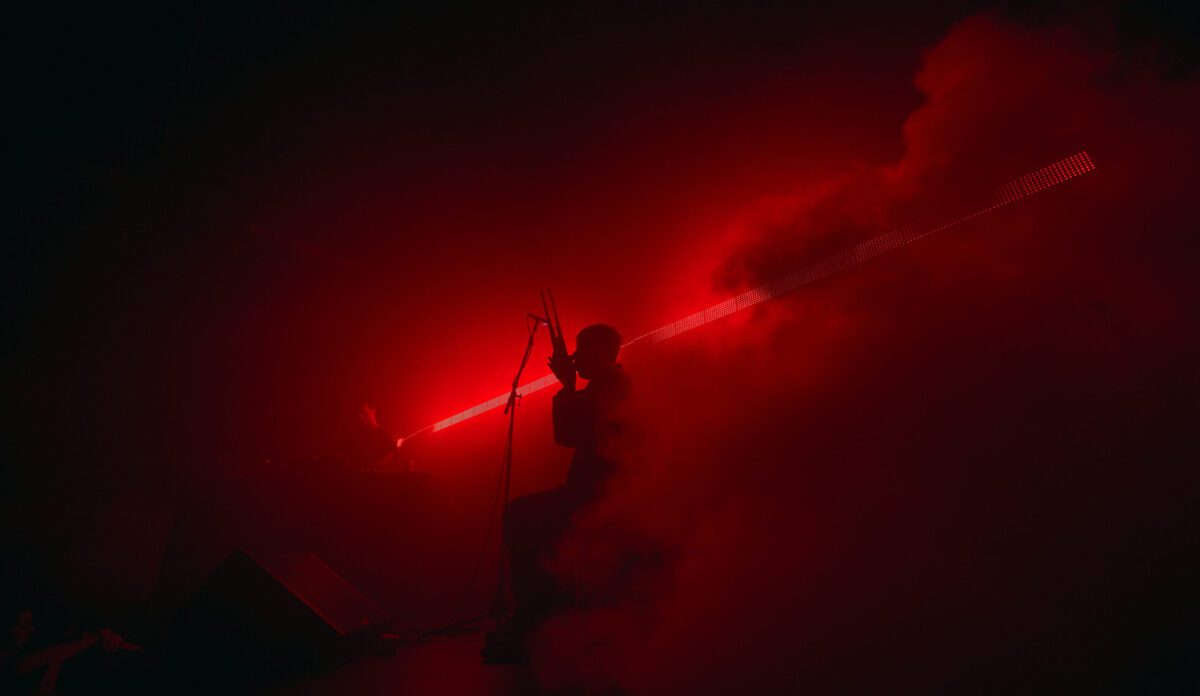
// Bruno-Aiello-Destombes
There’s no need to rehash the career of Tim Hecker, one of Canada’s most respected electronic composers. No Highs, his most recent album, is the expected extension of his most remarkable approaches. An ace of saturated frequency superimpositions, Tim Hecker has not been content to build these richly layered works despite their apparent linearity. His latest album is a long sinusoidal curve, so shallow that it can flatten out before resuming its roundness. Over time, the composer has added an instrumental dimension to his proposals: the bass clarinet is tangible on his new album, to cite just one example.
Hecker’s live performance is by no means an exact reproduction of his recent discography. The distortion effects may be more violent, the pulsations heavier (and wham in the plexus!), the quotations sometimes different, taken notably from the Anoyo and Konoyo recordings, which are largely Japanese-inspired. But these subtleties blend discreetly into the sometimes searing flows of this coherently performed concert. Pure Tim Hecker, no doubt about it.
– Alain Brunet
From the very first notes of Tim Hecker’s performance, we could recognize the sound world of his 2018 album Konoyo. Frames of instruments belonging to Japanese Gagaku began a long session of ambient drone, always navigating between harmony and dissonance. The hichirki glissandi that so distinctly opened the piece “This Life” then came to color the abrasion, serving as a transition to a new passage. Considering that it was the music of No Highs (2023) that was in the spotlight, these nods to an earlier album created a subversive effect. The same goes for Fumiya Otonashi’s shô interventions, unfortunately, inaudible during the first part of the concert.
More generally, the audience was treated to a forced immersive experience, with low frequencies so intense you could feel them through your body. Fortunately, Tim Hecker’s music is fascinating, and we happily play along behind his analog and digital machines.
– Laurent Bellemare
